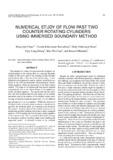Numerical study of flow past two counter rotating cylinders using immersed boundary method

View/
Date
2015Author
Ming-Jyh, Chern
Purnadiana, Farida R
Noor, Dedy Z
Horng, Tzyy-Leng
Chau, Shiu-Wu
Odhiambo, Ernest
Type
ArticleLanguage
enMetadata
Show full item recordAbstract
The adoption of a direct forcing immersed boundary nu-
merical method on the uniform flow, at a moderate Reynolds
number of 100, past a pair of two rotating circular cylinders
placed side-by-side, is the core of the present study. A sim-
plified yet novel approach is used to impose a virtual force as a
source to the full incompressible two-dimensional Navier-
Stokes equations, which are discretized by the finite volume
method. The usage of a Cartesian grid that ensures minimal
computational cost, is the sali
ent feature of the applied im-
mersed boundary approach. The gap between the two cylin-
ders, and their rotational direction and speed, are the variable
parameters used in the analysis of the resulting vortex street.
A range of absolute rotational speeds (
(g* 3)
3) for different
gap spacings (
g
*
3), is considered. Whilst the direction of
rotational motion is found to e
ither accelerate or decelerate the
gap flow, the rotational speed has a bearing on the dominant
flow pattern. An observation of the vorticity contours for the
decelerating gap flow indicates
that when a critical rotational
speed (
≈
1.4) is reached, the flow becomes steady regardless
of the variation of
g
*. Five
-dependent flow modes emerge;
the anti-phase, in-phase, flip-flop, single vortex shedding and
suppressed modes. A statistical scrutiny of the validated ransient data for the lift (
L
C
) and drag (
D
C
) coefficients is
ultimately performed. When
g
* = 0.2, the general trend of
decreasing
D
C
with reduction in gap size is broken.
Citation
Chern M-J, Purnadiana FR, Noor DZ, Horng T-L, Chau S-W, Odhiambo E. "Numerical study of flow past two counter rotating cylinders using immersed boundary method." Journal of Marine Science and Technology. 2015;23(5):761-773.Publisher
University of Nairobi
